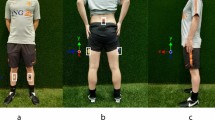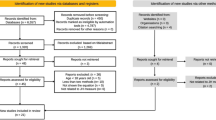Abstract
Mountaineers and rock climbers use a belay device to increase tension in the rope that links the belayer to a falling climber—this rope slows and finally stops the fall. With a manual (passive) belay device the belayer can hold a force of several kN although he/she applies a hand force of only 0.2–0.35 kN on the rope; i.e. the device increases the hand force by a factor between 5 and 10. This investigation provides dynamic measurements of force amplification by various manual belay devices when used on a range of both wet and dry climbing ropes and it examines the source of force amplification in these devices. The force amplification is found to be due to a combination of friction and distortion of the rope as it traverses around tight corners within the device. In modern devices, the tension amplification due to distortion exceeds that due to friction.










Similar content being viewed by others
Notes
Rope speed through the device had little effect on the amplification. For each device, an increase in rope speeds from 0.042 to 0.074 m/s resulted in less than 3 % decrease in amplification. This is in agreement with experiments by Fenz [8] on friction between woven PTFE and stainless steel but it contradicts the viscous force assumptions made in the analysis of Fuss and Niegl [9].
References
Titt J (2009) Belay device theory, testing and practice. http://www.bolt-products.com/Glue-inBoltDesign.html
Manin L, Richard M, Brabant J-D, Bissuel M (2006) Rock climbing belay device analysis, experiments and modelling. In: Moritz EF, Haake S (eds) Engineering of sport 6. Springer, Berlin, pp 69–74
Beverly M, Attaway S (2005) Hang em’ high: how far can you trust your belay device. Int’l Technical Rescue Symposium
Pavier M (1998) Experimental and theoretical simulations of climbing falls. Sports Eng 1:79–91
Attaway S (1996) Rope system analysis. http://lamountaineers.org/xRopes.pdf
Jung JH, Pan N, Kang TJ (2008) Generalized capstan problem: bending rigidity, nonlinear friction and extensibility effect. Tribol Int 41:524–534
Belofsky H (1976) On the theory of power transmission by V-belts. Wear 39:263–275
Fenz D (2002) Frictional properties of non-metallic materials for use in sliding bearings: experiments. http://mceer.buffalo.edu/publications/reesaccom/02-SP09/pdfs_screen/19_Fenz.pdf
Fuss FK, Niegl G (2010) Understanding the mechanics of dynamic rope brakes. Procedia Eng 2:3323–3328
Nikonov A, Saprunov B, Zupancic B, Emri I (2011) Influence of moisture on functional properties of climbing ropes. Int J Impact Eng 38:900–909
Spierings AB, Henkel O, Schmid M (2007) Water absorption and the effect of moisture on the dynamic properties of synthetic mountaineering ropes. Int J Impact Eng 34(2):205–215
Song J, Ehrenstein GW (1990) Effect of water uptake on the properties of polyamides. Kunstst Ger Plast 80(6):722–726
Cotugno S, Mensitueru G, Musto P, Nicholais L (2010) Water sorption and transport in polymers. In: Nylon and ropes for mountaineering and caving Turin: Italian Alpine Club Technical Committee, 8 March 2002; CCMT Centro Studi Materiali e Tecniche
Persson BNJ (2001) Theory of rubber friction and contact mechanics. J Chem Phys 115(8):3840
Nakada M, Demura S, Yamaji S, Nagasawa Y (2005) Examination of reproducibility of grip force and muscle oxygenation kinetics on maximal repeated rhythmic grip exertion. J Physiol Anthropol Appl Human Sci 24(1):1–6
Author information
Authors and Affiliations
Corresponding author
Appendices
Appendix 1
1.1 Measurements of COF for various ropes
The kinetic COF between the mantel of the rope and polished Aluminium was measured for rope sliding over a large radius Aluminium cylindrical bar. The ends of the rope on either side of the bar were loaded by weights representing (1) hand force and (2) tension in the rope connected to the falling climber. For the minimum difference in weights where the rope slipped freely over the cylinder, these measurements were used in Eq. (2) to obtain an estimate of the Coulomb friction coefficient.
Note that the COF between the nylon rope and aluminium is decreasing with increasing hand force; a result previously noticed by Titt [1]. For rubber sliding on aluminium, Persson [14] showed a similar decreasing kinetic COF with increasing normal pressure; he attributed this to vibrational energy dissipation excited by the relatively soft polymer sliding over hard asperities on the aluminium surface. Fenz [8] measured friction between woven PTFE and stainless steel which again exhibited a decrease in friction coefficient with increasing pressure, possibly due to lubrication by surface melting of the high points on the polymer.
Appendix 2
2.1 Measurement of “hand force”
Table 4 lists the mass in kilogram of the maximum weight lifted by a recreational rock climber using either the left or right hand gripping a 9.4 mm diameter climbing rope. These tests were conducted with either a bare hand or the hand covered by a pigskin belay glove and without wrapping the rope around the hand.
The tests indicate a wide range of hand force (grip strength) varying from 0.074 to 0.368 kN. With a belay glove, the hand force is slightly smaller. Generally, these forces are larger than the 0.16 kN quoted by Manin et al. [2]. For Table 4 the duration of gripping the rope is <10 s, similar to the time occurring while holding the initial jolt during a climbers fall [11]. The grip strength decreases with increasing time after this initial period [15].
Additional tests on just 2 recreational climbers measured the influence on hand force (grip strength) of rope diameter and whether the rope was wet or dry. The tests were conducted on an Apollo 11 mm, Booster Dry 9.7 mm and Ice Line Dry 8.1 mm ropes; either dry or after soaking in water for 12 h. The results indicated that there was no significant influence resulting from whether the rope was dry or wet. There was however, a significant reduction in hand force for the smaller diameter ropes. For the 8.1 mm Ice Line the hand force was 70 % of that for the 9.7 mm Booster rope. No significant difference in grip strength occurred between the 11 mm Apollo and the 9.7 mm Booster ropes (Table 5).
Rights and permissions
About this article
Cite this article
Stronge, W.J., Thomas, M. Effectiveness of mountaineering manual belay/abseil devices. Sports Eng 17, 131–142 (2014). https://doi.org/10.1007/s12283-013-0147-6
Published:
Issue Date:
DOI: https://doi.org/10.1007/s12283-013-0147-6




